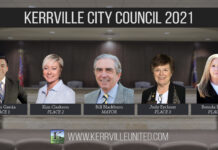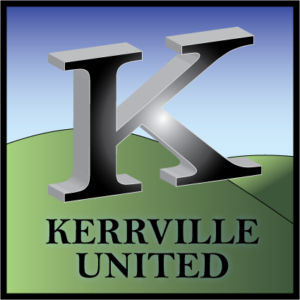The city council recently granted the contract for the construction of a 105 million gallon water reuse storage pond near the water treatment plant on Loop 534. This has been a contentious issue that has grown to include concerns about the future of Kerrville’s water supply as well as the future of some of Kerrville’s youth sports leagues — namely youth soccer.

To shed a little more light on the issue, here is a FAQ provided by the City of Kerrville that addresses some of the major concerns. Editor’s Note: This is cut and pasted from a city document found online here: http://kerrvilletx.gov/DocumentCenter/View/26331
Question: Why did the City begin to explore the need for a reuse water supply facility (effluent pond) in the first place? Why does Kerrville need it?
Fact: Enhancing and diversifying the City’s water supply has been a key priority for the Kerrville
City Council for decades. Building a reuse water supply facility has been extensively explored over the last four years under the following basic assumptions and policy direction expressed by City Council:
– Expanding the City’s future available potable water sources via Direct Potable
Reuse (DPR) is a wise decision. The City owns the resource (effluent from the Waste
Water Treatment Plant aka “WWTP”) and diverts a portion to large irrigation users.
However, without storage, most of the effluent currently flows into a creek and the
City gives up ownership
– Expanding the City’s ability to distribute treated effluent to large irrigation users to
help reduce the use of potable water for irrigation purposes is a wise decision. It
helps preserve potable water resources for citizens and businesses, while utilizing a
resource (WWTP effluent) that otherwise would be wasted
– Water production and demand (both potable and non-potable) varies on an
annual, monthly, daily, and even hourly basis thus requiring water storage facilities
at various points throughout the collection, treatment, and distribution process in
order to provide a service that is cost effective and efficient
Question: Isn’t this project only about irrigation of golf courses and athletic facilities?
Fact: No. This project will help better ensure the long-term water supply resources for citizens and businesses by expanding this alternative water supply.
Question: I’ve heard that if you look at the annual, or even the monthly, current reuse demand and production data it seems like the current (and future) effluent and DPR demand can be met simply by extending distribution lines to users and increasing pump sizes, without the need for the effluent pond. Why is the pond needed?
Fact: Annual and monthly demand and production data are not granular enough to show the gaps between when reuse water is needed by customers and when it is produced at the WWTP. The production and distribution of reuse effluent must take into account multiple factors including sewer plant operations, logistics, timing, equipment efficiency, and infrastructure parameters. The anticipated demand for reuse water must also take into account a host of variables including rainfall, temperature, athletic seasons, usage, etc. In essence, balancing reuse water demand and supply is a complex daily and even hourly operational issue, as there is no current storage capacity for the City’s effluent. Unfortunately, this causes most of this effluent to be “wasted.” The effluent pond will provide a “buffer” to bank the resource, the City will maintain ownership, and it will help the City better match this water resource with its customers’ demand.
Question: I’ve heard the project may cause flooding. Is this project safe?
Fact: The City’s consulting engineer has completed extensive design work. The project will result in zero flooding impact to any non-City property. Following the completion of the design, the City will submit information to FEMA to confirm its study.
Question: Does the City currently utilize other water storage methods?
Fact: Yes. The City utilizes Nimitz Lake to “bank” pretreated water. In addition, the City utilizes
underground aquifer storage to “bank” treated water. Water storage facilities are generally located as close as possible to the source of the water or where the water is produced. Given that the WWTP is the source of the City’s effluent water supply, the most cost efficient option for water storage of this resource is City-owned property directly adjacent to the WWTP.
Question: Couldn’t the City just put the WWTP effluent back into the Guadalupe River or Flat Rock Lake and then pull it back out as needed, without the need for additional storage? What about doing the same thing with one of the City’s aquifer storage and recovery wells?
Fact: No. The City explored this option but state law prohibits the City from doing this without 1)
treating the water to a higher standard; and 2) losing a very high percentage (~80%) of its
ownership rights to the effluent.
Question: Couldn’t the City require the effluent users to build their own storage facilities so that the City wouldn’t have to build the pond?
Fact: The City is requiring each of the larger reuse water customers to build an onsite storage
facility. Were the City to require an increase in the size of the individual facilities to accommodate the gaps in production versus demand, it is doubtful that the customers would agree to build them. Most importantly, once reuse water is sent to private users, the City no longer owns the water resource, which would preclude the City from being able to store pre-treated water for direct potable reuse, limiting the resource as a potable water supply.
Question: How much is the project estimated to cost? Will it raise my taxes?
Fact: The construction of the water storage facility, in addition to the extension of the distribution lines, and additional pump infrastructure is estimated to cost $18.5 million. The project will be funded solely from utility revenues. No utility rate increases are anticipated for this project.
Question: Are there any less expensive options than building a reuse water storage facility?
Fact: The City has diligently explored options to expand the City’s water supply for many years. A reuse water storage facility is the least expensive option to enhance the City’s long-term pretreated water supply, taking into account both the initial infrastructure costs as well as the long term maintenance and operations costs of the infrastructure required. It also provides the community with the maximum amount of control and ownership over the resource, a resource that may eventually become direct potable reuse water.
Question: Is this decision being rushed? Why haven’t I heard about it before? Why is it critical to get started soon?
Fact: The City began researching this option over four years ago. During this time, City Council has considered various aspects of this issue at over 15 separately posted public meetings. In addition, Council appointed an ad hoc citizen committee in 2015 to review the project and provide input and a recommendation to Council. Following this time period and process, the City believes that it has covered all the issues, considered all the options, and has embarked upon a plan that is both cost efficient and will secure a reliable alternative water resource for the community now and into the future.




